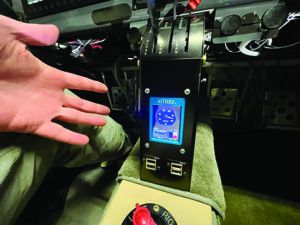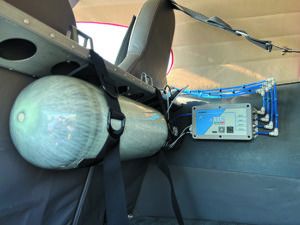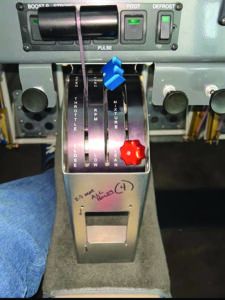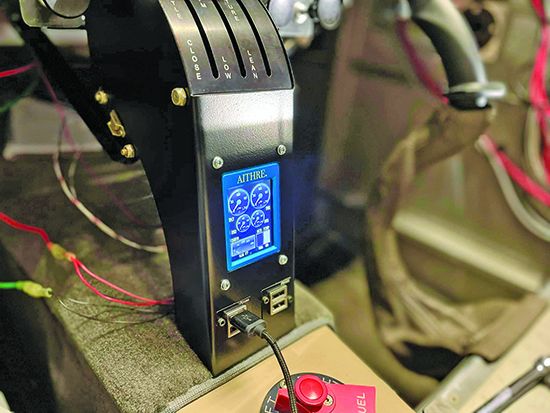In just a few short years we’ve watched Aithre’s cockpit biometric product line grow from smart SpO2 and portable O2 tank sensors to integrated oxygen systems, and now a panel-mounted multifunction biometrics display.
As far as we know, the Aithre Healthview is the first of its kind dedicated and permanently mounted cabin health and enviromental system. The company was showing off the Healthview, priced at $895, in its Van’s RV-10 at the Sun ‘n Fun Aerospace Expo last month. We took a look at a preproduction interface and the physical installation.
FORM FACTOR, EFFICIENCY
Packaged in an aluminum anodized laser-etched chassis, the Healthview is small and light, measuring 3.5 by 2.4 by 0.84 inches and weighing 10 ounces. But it’s all screen—touchscreen—with no bezel knobs or buttons to eat real estate. In the company RV-10, the display was mounted in the lower center pedestal.
The 240 by 320 pixel TFT resistive touch color LCD display is efficient, with low current draw (150 mA), and the Healthview works with 12- and 24-volt electrical systems. The wiring interface is straightforward and requires a 1-amp circuit breaker that isn’t connected in series with a critical and required essential bus. There’s a power wire, ground wire and RS-232 serial data lines that connect between the Altus AVI O2 control box and the display. There’s also a simple wire interface from the optional wingtip-mounted Metis temperature/dewpoint sensor.
USEFUL, INTUITIVE DATA

Since the Healthview has a built-in barometric pressure sensor, it works as a standalone cabin pressure altitude display. But the objective of the Healthview is integrating all of Aithre’s wireless biometric sensor data, plus a controller/display for the AVI integrated cabin oxygen system.
At power-up, the Healthview searches for any Aithre sensors in proximity and as they are connected, the electronic color-coded round gauges and bar graphs are populated on the screen. If a device isn’t found, there will still be a gauge or graph present, but partially blanked to indicate there’s no data. Healthview can present SpO2 and oxygen usage rate for up to six Illyrian sensors/paxs.

The Healthview home screen is divided into two parts: the focus section at the top (consisting of four gauges) and the panel section at the bottom. The two sections operate independently of each other. Up at the top, a green gauge labeled O2 shows the oxygen tank pressure (an indicator points to the PSI value as sensed by the Aithre Meso device). A black gauge for CO value displays the cabin carbon monoxide levels as measured by the Aithre Shield CO detector. The blue gauge labeled SpO2 shows the SpO2 level of the pilot and a darker blue gauge shows oxygen flow (in liters per minute) for the pilot. You can also select a passenger’s O2 flow value as a dedicated gauge, or SpO2 gauges for up to four passengers.

The display is interactive and as an example, you can touch the O2 and CO gauges on the focus screen to enlarge them for a more accurate reading of the remaining oxygen and CO levels. The gauges stay enlarged until you touch them again.
The bar graphs sections at the lower portion of the screen operate independently from the focus gauges, and cycle through various information screens by automatic scrolling or by operator touch. The first rectangular bar displays the cabin altitude. The one next to it is labeled Air and it presents a pictorial representation of where the aircraft is within the atmospheric regime. Maybe it shows 99 percent, which would be the percentage value of the atmosphere that’s present at the current altitude, as compared to sea level. The other bar graph is for cabin temperature data when connected to an appropriate sensor.
CLIMATE DATA, WARNINGS
For experimental aircraft, the Metis temperature/dewpoint sensor is used for displaying climate data in bar graph format at the lower portion of the screen. The data in this bar graph section includes freezing, cloud, dewpoint, temperature and humidity information for the location where the sensor has been mounted on the aircraft. The displayed freezing level is the current Metis temperature adjusted using the standard lapse rate. When this calculated value is within 5 degrees of freezing, the onscreen square will change from black to blue.
Taking displayed climate data another step, when the dewpoint is calculated to be within 5 degrees of the calculated temperature, the onscreen cloud square will change from black to a blue/grey color. Remember that these values aren’t really predictive of actual weather, but instead serve as a potential warning that clouds and ice may develop based on the sensor. There are three bar graphs next to the Climate squares for measured dewpoint, OAT and relative humidity.
The cabin warning system has individual alerts, including high carbon monoxide levels (greater than 50 ppm), low oxygen tank supply (less than 500 PSI remaining), low cabin pressure (greater than 8000 feet) and high cabin temperature (greater than 37 degrees C).
It’s smart alerting, too—if two or more warning conditions occur simultaneously, both will present, and if one cabin warning condition has previously presented and another cabin warning occurs, only the new warning will be presented.
There is also an individual warning screen dedicated to pilot and passenger biometric alerts. This includes low SpO2 levels (less than 85 percent), high heart rate (greater than 110 BPM), a stopped oxygen flow condition and low respiration rate. Each alert has its own warning screen and if two or more conditions occur at the same time, both will be presented. There’s even a warning system for the optional climate data when the Metis sensor is installed.
GOOD VALUE
At $895 (not counting the bio sensors and O2 system) we think the Aithre Healthview (available later this spring) has serious utility for presenting useful cabin and passenger biometric stats. We’ll keep tabs on the product as the final production model hits the market. Visit www.aithreaviation.com and link to the Sun ‘n Fun demo below.

See a video on the Aithre Healthview display at
http://tinyurl.com/j95ht2a.





